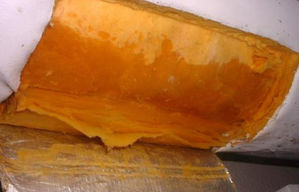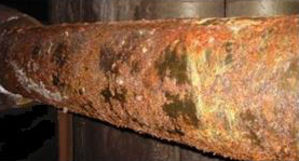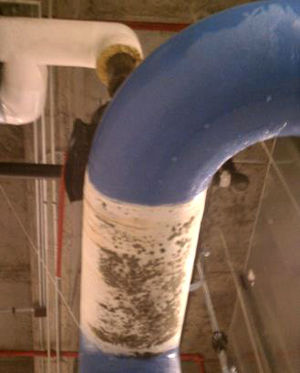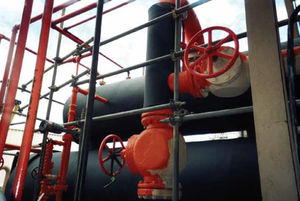By Thomas MacKinnon - EIT
Condensation: It’s Raining Indoors
In Part One of this post, we discussed that condensation forms on any surface at or below the dew point temperature of the ambient environment. This dew point temperature is based on the temperature of the ambient air and the percentage of water vapor in the air based on the maximum amount it could hold, or relative humidity. This can be especially worrisome if your system surface temperature is below the dew point temperature of the surrounding air as the water vapor in the surrounding air will condense into a liquid on your system.
To prevent condensation from forming, adding insulation of the proper thickness is vital to raise the surface temperature above this dew point temperature. If the insulation is porous, such as fibrous insulation, a vapor retarder is absolutely necessary to prevent the water vapor from passing through the insulation and condensing on the surface of the pipe.
The subject of this post is what happens when condensation still forms as a result of a miscalculation or poor installation of the insulation material.
Part One can be found here.
Moisture Ingress: Soaking Water Up like a Sponge
 Porous insulation materials, such as the fibrous insulations, rely on a vapor retarder to protect from water vapor accumulation between the fibers. Unfortunately these vapor retarders are not completely impenetrable and often get nicked or torn open through the regular maintenance process or are not completely sealed during installation due to difficult configurations or space constraints. With any gap in the vapor retarder, water vapor will start accumulating between the voids like a sponge soaking up water, but with dire effect. with every Every 1% increase in moisture gain translating translates into an incredible 7.5% loss in thermal value. After all the voids are filled, condensate will start to accumulate on the exterior surface of the insulation and the system itself, forming a thermal bridge with a thermal conductivity of water (4.1 Btu/(hr ? °F ? ft2/in) at 75°F mean temperature). This thermal bridge causes large heat gains within your below-ambient system as the insulation switches to a conductor of heat and the efficiencies of your system will drop precipitously. This water being held in close proximity of the system can also lead to other issues, affecting the material you were trying to protect in the first place.
Porous insulation materials, such as the fibrous insulations, rely on a vapor retarder to protect from water vapor accumulation between the fibers. Unfortunately these vapor retarders are not completely impenetrable and often get nicked or torn open through the regular maintenance process or are not completely sealed during installation due to difficult configurations or space constraints. With any gap in the vapor retarder, water vapor will start accumulating between the voids like a sponge soaking up water, but with dire effect. with every Every 1% increase in moisture gain translating translates into an incredible 7.5% loss in thermal value. After all the voids are filled, condensate will start to accumulate on the exterior surface of the insulation and the system itself, forming a thermal bridge with a thermal conductivity of water (4.1 Btu/(hr ? °F ? ft2/in) at 75°F mean temperature). This thermal bridge causes large heat gains within your below-ambient system as the insulation switches to a conductor of heat and the efficiencies of your system will drop precipitously. This water being held in close proximity of the system can also lead to other issues, affecting the material you were trying to protect in the first place.
Corrosion Under Insulation (CUI)

One of these issues is Corrosion Under Insulation (CUI) or the formation of corrosion on the system surface when water is trapped between the surface of the system and the insulation. While CUI can form because of a system failure (leaks) or improper weather protection, it can also occur when condensation finds its way to the surface of the pipe through a break in the vapor barrier. Moisture Ingress in porous materials can lead to CUI as the insulation holds on to the water right next to the system itself, wrapping the metal with a wet covering and providing the means to form corrosion. However, CUI can also form with non-porous materials if the water vapor finds a gap in the vapor barrier and proceeds to condense under the insulation. The same insulation that was preventing the water vapor from passing through to condense on the system would now prevent it from passing back out and away from the system, keeping the water close and also providing the means to form corrosion. Any system that is subjected to corrosion will, of course, not operate as expected as the metal starts degrading and the maintenance cost of replacing the damaged system will be quite high. Left alone long enough and this corrosion may lead to a complete failure breakdown of the system and a far more catastrophic failure.
Mold
 Mold is made up of various types of fungi that can grow on almost any surface that stays between 32°F and 120°F (optimally between 70°F and 90°F) with no air flow and is damp with moisture¹. If condensation forms within the insulation and the insulation stays damp, it creates the perfect environment for this mold growth to begin, often without any trace on the outside of the insulation. This mold can then propagate throughout the insulation and start to form on the surface, where it can travel throughout the air space and lead to allergies, rashes, asthma attacks, and overall poor air quality within the space.
Mold is made up of various types of fungi that can grow on almost any surface that stays between 32°F and 120°F (optimally between 70°F and 90°F) with no air flow and is damp with moisture¹. If condensation forms within the insulation and the insulation stays damp, it creates the perfect environment for this mold growth to begin, often without any trace on the outside of the insulation. This mold can then propagate throughout the insulation and start to form on the surface, where it can travel throughout the air space and lead to allergies, rashes, asthma attacks, and overall poor air quality within the space.
Some insulation products do come with an antimicrobial protection, like Armacell’s ArmaflexArmaFlex family of Insulations insulation with Microban®,antimicrobial technology built into the formula to inhibit the growth of mold on the insulation, even if the above conditions are met. This provides peace of mind when insulating a below-ambient system that even if condensation were to form in the system, the occupants will be safer from Indoor Air Quality issues.
Conclusion: Do it Right the First Time
With below-ambient systems, condensation formation is always a risk. If the system is not insulated correctly, Moisture Ingress, CUI, and Mold will soon follow the first drop of condensation. Not only will the insulation have to be replaced if the condensation formation is not identified in time, but the system piping, ductwork, or other components themselves along with any surrounding equipment that the condensation was dripping on will have to be replaced as well. So make sure the system is insulated with the right thickness of insulation and a complete vapor barrier to avoid these condensation risks.
_______________________
¹Michael Pugliese, The Homeowner’s Guide to Mold, Reed Construction Data, Inc ©2006

Why Armacell?
Armacell’s family of insulation products is especially good at protecting your system from the effects of condensation. Not only do these products boast extremely low water vapor absorption and water vapor permeability, they also do not rely on a jacketing or additional vapor barrier system to protect from condensation formation. The closed-cell nature of the Armacell products are inherently durable and mean that any surface nick or tear of the material will only expose more low-permeability closed-cells; a fact that is not shared with porous or fibrous insulation. With the inclusion of Microban®, an anti-microbial technology, you can rest assured that your system insulation is protected from the effects of mold or mildew. Armacell’s products will give long term condensation protection and will retain their performance for the life of your system.
Tom MacKinnon is the Eastern Market Development Manager for Armacell and works closely with Engineers, Owners, and Specifiers, answering their insulation questions and helping to create insulation specifications that meet their project needs. He is a Mechanical Engineer from Stevens and currently lives in Northern New Jersey.
For more information about contacting your regional technical representative, click here.
If you would like a PDH-accredited Lunch & Learn Presentation on insulation for your office, click here.
